AGRONOMIC UPDATE JULY 12, 2023….Weather pattern change?….
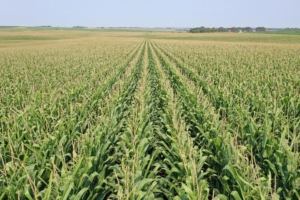
Topics:
– Growing Degree Day Update/Forecast Maps
– What’s going on in my fields?…..Corn Development, etc.
– Fungicide/Disease in Corn
– Insect Update
– Soybean Development
As of July 11th, we have accumulated approximately the following for Growing Degree Days in 2023:
TEMPERATURES & GDU ACCUMULATION:
Planting Date GDD’s2023 Average GDD Departure from average
April 17 1445 1411 +34 (+1.5 days)
April 26 1401 1352 +49 (+2 days)
May 9 1270 1243 +27 (+1 day)
Since the last update on June 29th, we have continued to lose ground on GDU accumulation. We are now just ahead of the average, whereas a month ago we were 8-9 days ahead of the average. Last year we were 2 days ahead of average at this time. The fields are reflecting this as well as the time to tassel has been slowed up with the cooler temperatures of the past two weeks. The below maps point this out:
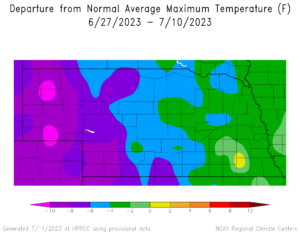
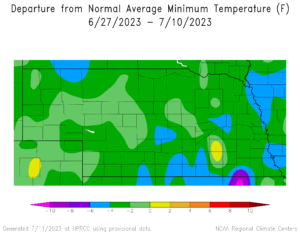
Both maps show departure from normal maximum and minimum temperatures over the past 14 days. Our area is 4-6 degrees below average for daily high temperature and 4 degrees below average for daily low temperature over this time frame. Over the past 14 days, average high temperature has been 80 degrees and average low temperature was 61 degrees. Average high temperature in 2022 for this same period was 87 degrees with average low temperature of 66 degrees. This equates our to about 80 GDU’s with is 3+ days. Normal GDU accumulation is 25/day. Currently we are seeing 20-22/day. Hence, fields are silking about 3-6 days later than anticipated back in June. While the temperatures of the past two weeks has been a positive for crop stress, they have greatly increased potential for disease outbreaks in both corn and soybeans. More on this further into the update.
What’s forecasted for the next two weeks?
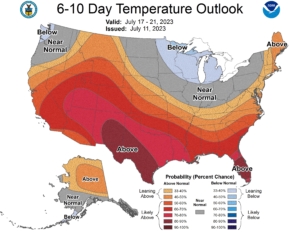
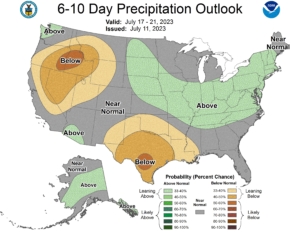
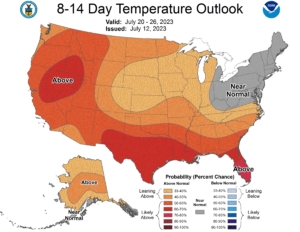
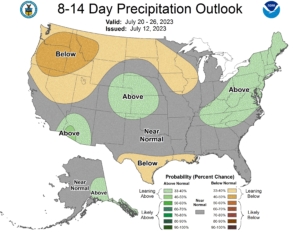
The above maps show the temperature and precipitation outlooks for the next 6-10 and 8-14 day periods. As one can see, the outlooks are best of both worlds…above normal temperatures with above normal precipitation. This will be great for pollination and early grain fill. We still need some heat to keep the crop progressing. However, while they keep predicting more heat, it never seems to quite make it, which usually happens under a wet weather pattern. So, I’m taking this with ‘a grain of salt’…..
What’s going on in my field?….
- Baring the fields that were caught in Monday’s hail, much of the corn crop looks good overall. Much of the corn crop is in the V16-VT-early R1 stage, with tassels starting to show up throughout the area depending upon hybrid and planting date. This is slightly ahead of last year. From V10-VT, corn gains a new color every 50 GDU’s, or about every other day. Majority of the fields will tassel fully by the end of the week, with the later planted fields doing so early next week.
- Kernels per row began around V12 and is continuing through and up to tassel stage
- Nitrogen needs will continue to grow through tasseling and into early reproductive stages. Nitrogen uptake in corn is very rapid now through tassel (up to 4-8 lbs per day). As we have discussed in the past, today’s hybrids use nitrogen later in the growing season and into the reproductive phases. You will want to keep that last shot of N available for after tasseling….40-50# Prior to the past 10 days or so, expectations have been low for N leaching from excessive rainfall. However, many sandy areas saw heavy rains over the past two weeks, so we would expect that some N leaching occurred during these rain events. Keep this in mind as you determine your final N applications.
- We are now into the rapid growth and accumulation of dry matter by the plant. The window for brittle snap is still open over the next 5-10 days.
- Under field conditions, pollen shed usually occurs in the late morning and early evenings.
- Pollen shed will extend for one to two weeks, but if field is uniform in plant emergence and height, pollen shed is 80% complete in 5-7 days from full tassel emergence….this will take place end of this week thru next week for most fields.
- At tassel, vegetative development is now complete; maximum plant height and root depth is achieved.
- VT overlaps with R1 (silking stage) when visible silks appear before the tassel is fully emerged. By definition, growth stage R1 (Abendroth et al., 2011) for an individual ear is defined when a single silk strand is visible from the tip of the husk. An entire field is defined as being at growth stage R1 when silks are visible on at least 50 % of the plants. This whole field definition for growth stage R1 is synonymous with the term “mid-silk”.
- A captured pollen grain takes about 24 hours to grow down the silk to the ovule for fertilization.
- Peak pollen shed usually occurs in mid-morning. Some research indicates that pollen shed decreases after temperatures surpass 86F. A second “flush” of pollen often occurs in late afternoon or evening as temperatures cool. Pollen shed may occur throughout most of the day under relatively cool, cloudy conditions….. Crop Focus – Corn Pollination Success
- Weather conditions influence pollen shed. If the anthers are wet, the pores will not open and pollen will not be released. Thus, on an average summer morning following a heavy evening dew, pollen shed will not begin until the dew dries and the anther pores open. Similarly, pollen is not shed during rainy conditions. Cool, humid temperatures delay pollen shed, while hot, dry conditions hasten pollen shed.
- Generally 2-3 days are required for all silks on a single ear to be exposed and pollinated, with the silks on the butt of the ear emerging first. The silks will grow from 1-1.5 inches each day and will continue to elongate until fertilized. If not pollinated, silk elongation stops about 10 days after silk emergence due to senescence of the silk tissue. Unusually long silks can be a diagnostic symptom that the ear was not successfully pollinated.
- Silk emergence and growth is dependent upon turgid pressure within the plant, in other words how much water is available in the plant to cover all of its needs. If this is limited, (ie. dryland, low-gallon wells, etc.) silk emergence will be slowed and delayed with potential to miss the pollen shed. Under severe water stress conditions pollen shed will still take place like normal, however, silks can be delayed, which means potential for poor pollination.
- It takes approximately 55-60 days from silking (R1) to physiological maturity. So if a field is silking on July 15th, it will need until September 15th to reach maturity, given average weather. Current 6-10 and 8-14 day forecasts call for above normal temperatures, which should give us a GDD accumulation of 25-30 GDU’s per day.
- High nighttime temperatures (ie. any stress) begin to play a role in final yield during grain-fill as this causes the plant to work harder to maintain both yield and overall plant health, thereby lowering potential final yield.
Corn Leaf Disease/Fungicide
- The next four to six weeks will be critical for disease infestations and fungicide applications. Keep in mind that if we continue to see cool temperatures and wet conditions, potential disease outbreaks will increase exponentially.
- Begin scouting now and through the next few weeks for disease infestations. So far, leaf disease load in area cornfields is very low, mainly bacterial leaf streak, however, we have seen some Northern Corn Leaf Blight lesions and, with the wet conditions, we are starting to see the first Common Rust show up. We are not seeing any Tar Spot in the area. We keep you posted on this disease if we find it….
- If you are planning on only one fungicide application, the best timing for this application is after pollination as the crop is working the hardest at this time and has the highest demand for energy. We want to protect as much of the leaf surface as possible in this time frame, which is from pollination and the two weeks after. Corn on corn acres are always a good place to start with fungicide applications.
- While any hybrid can have a response to foliar fungicides, hybrids such as P0622, P0924, P0950, P0908, P0995, P1185, P1278, P1366 & P1563 are hybrids to focus on first for higher probability of response from foliar fungicides, especially if gray leaf spot infestations are high…..2023 Pioneer Foliar Fungicide Guide – Nebraska ….This attachment is a list of Pioneer hybrids and their potential response to a fungicide application for Gray Leaf Spot and Norther Corn Leaf Blight. The chart also shows staygreen and stalk strength ratings for each hybrid. This chart can help with fungicide management decisions.
- See attachments on disease and fungicide management – Maximizing Foliar Fungicide in Corn and Bacterial Leaf Streak
- Fungicide Efficacy for Control of Corn Diseases This attachment shows efficacy and posted residuals by active ingredient for different leaf diseases, for the current fungicides on the market. This is a good reference sheet on fungicides….
Water Management
We have finally been blessed with rainfall…we have experienced the old saying, ‘when it rains, it pours’, in many areas. As so often happens, we go from desperately needing moisture to excessive. We have had a 200-300% increase in rainfall over the past two weeks versus the average….see map below:
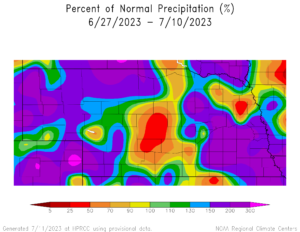
For the year, my weather station is only 1″ below normal now!
Below are some key water management tips to keep in mind:
- The greatest yield loss from moisture stress occurs in the period two weeks prior to two weeks after pollination. For the next two weeks, the corn crop will be at its peak water usage, with ET rates of .30+ inches per day – higher when temps are in the mid-90’s and higher yet when combined with low humidity….lower under cool and cloudy conditions.
- ET rates over the past two weeks have been average…..20-.35″ depending upon temperatures, etc. However, we are reaching peak water use in corn, and with the potential higher temps forecasted out two weeks, it will be important to stay on top of overall water needs by the crop.
- At present, we are seeing fairly good root depth according to the soil moisture probes….sandier soils are 20-32” (better than average) and heavy soils are 28-40+” (average) depending upon plant date, conditions and soil type. Remember that maximum plant height and root depth are achieved once the plant tassels. The recent rains have filled up soil moisture profiles.
Insect Update
Western Bean Cutworm egg masses can be found in area, sandy fields. Keep these tips in mind over the next few weeks:
- To scout for this insect, check the sandier fields first and look on the upper side of the leaf for a white, or purple, egg mass. These will be found on the upper 1/3 of the plant.
- We again have pheromone moth traps located west of Elgin. Current numbers are slowing trending upwards, but too early to tell how heavy the flight will be.
- Treat when the fields are 95% tasseled. Use high rates (5-6oz) of a Capture-like product to give you 3-4 weeks of residual control.
- WBC are attracted to those fields that are closest to tasseling, so this means the later planted and later silking fields have the highest potential for infestations. Cool conditions will delay and extend their flight, so what may appear low numbers now can pickup in two weeks, which is why we recommend the extra residual.
- Once a field has been tasseled, any egg masses that hatch will see the larvae move straight to the ear tip, so treatment soon after tasseling is critical.
- AML versions of Pioneer hybrids offer control of WBC/Corn earworm. No need to treat these hybrids for WBC – these include P0622AML, P0908AML, P1122AML, P1366AML, P1563AML, & P2042AML.
Corn Rootworm
Adult beetle emergence is occurring right now, and will continue over the next few weeks. Monitor your continuous corn acres for adult beetle populations to:
- prevent high numbers interfering with pollination through silk-clipping. Males emerge first and this is what we are mainly seeing right now.
- help with rootworm control in your continuous corn acres. Strongly recommended to use Steward insecticide (by FMC) for control of adult beetle populations to help with next year’s control of rootworm. This product has shown excellent results for both kill and residual, which can be upwards of 30 days. As far as timing for control, it is best to wait until there are pregnant females present.
Grasshoppers….seeing some feeding in both corn and soybeans from small grasshoppers, mainly along borders and dryland corners and neighboring rye fields. The recent wet conditions should reduce grasshopper numbers moving forward. However, this insect is present in higher numbers than we normally see….keep an eye on this pest.
Soybean Development
- Most of the soybeans in our area are at late-R1 (Beg flower) to late-R2 (Full flower). I would not be surprised to see early R3 (pod set) on some fields next week. Most fields are finally coming around and growing.
- Soybeans should be nodulating heavily at this stage. At the beginning of the reproductive stage, soybeans will still put on 50% of their vegetative growth.
- Crop water use in soybeans starts to increase rapidly at full flower, peaks at R3 and will stay high through R6, or full seed Flower stage is usually the time when the soybean plant begins to pull from the deeper root zones….we see this happening on the soil moisture probes in the area. Heavy soil moisture profiles are full enough that very limited irrigation will be needed on soybeans through July, unless temps turn off hot.
- With the wet conditions of the past 10-14 days, we would not be surprised to see Iron Chlorosis symptoms show up again in high-pH areas…wet bottoms, clay hillsides. For this to ‘fix itself’, the fields will need to dry out. Variety tolerance to Iron Chlorosis will also play a role here.
- We continue to see a yield response from a fungicide application in soybeans, either at R1 for white mold (applications of which should be on or going on) and/or a later R3 (pod set) stage of growth. Environmental conditions over the next two months will determine disease incidence and overall level of disease infestation. Just a reminder, keep an eye out for Frogeye Leaf Spot in soybeans as not all fungicides control this disease. This disease is normally not an issue in our area and many varieties have very good tolerance to this disease. See attachment for more info on this disease….Frogeye Leaf Spot in Soybeans
- Recent weather conditions have increased the potential for White Mold. If current weather trends continue into August, expect White Mold outbreak to be heavier than we have seen the past few years. For White mold management see attachment: Managing White Mold in Soybeans
Palmer Amaranth Pictures
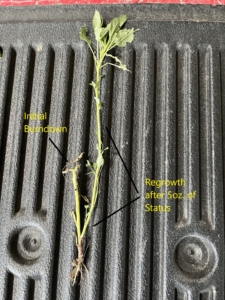

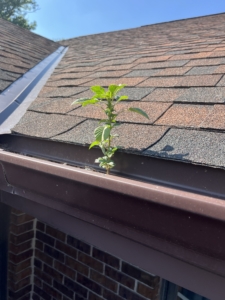
Palmer Amaranth/Waterhemp continue to be a difficult weed to control. The above pictures are re-growth after 6oz of Status applied five-six weeks ago. you can see how the plant was ‘burned’ down to a stem, but was not controlled for every node and eventually re-growth started. We continue to see more and more of this in both corn and soybeans across herbicide platforms. This weed needs to be controlled early…anything over 4-6″ and almost impossible to fully control. The herbicides have had value as they ‘set back’ the plant (reduced competition, etc.), but full control was not achieved (still have seed production). The last photo shows how hardy these buggers are! They can grow anywhere and don’t need much for soil depth….how healthy that plants looks in a rain gutter!….
Thank you for your business!! Please let us know any questions or concerns you may have!!
Starman Seed Service, Inc.

